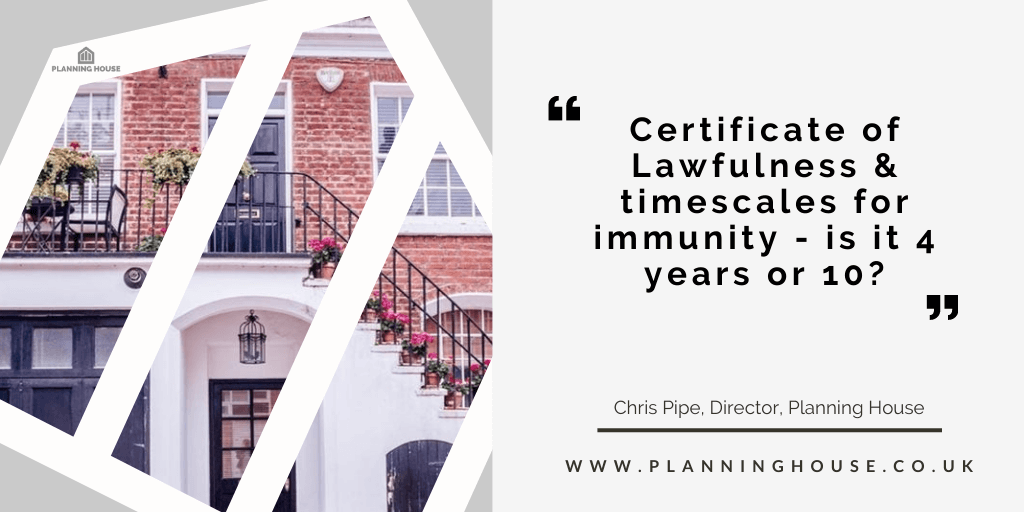Are you thinking of selling or re-mortgaging, but never received planning permission? Or are you being threatened with enforcement action for your existing development?
In most cases, a development becomes immune from enforcement if no action is taken within a certain timescale. Usually between 4-10 years depending on the development.
If this applies to you then you may want to apply for a Certificate of Lawful Existing Use or Development (CLEUD) to formalise the development. This is a certificate that retrospectively legalises a previously unauthorised development.
What timescale applies to CLEUD?
In most cases, your development becomes immune from enforcement if no action is taken:
- Within 4 years of substantial completion for a breach of control consisting of operational development (i.e. building works so for instance a conservatory, extension or other works).
- Inside of 4 years for a change of use to a single dwelling.
- Within 10 years for any other breach of planning control (i.e. breach of condition or other change of use).
We’re often asked about the 4 year rule and how it relates to residential use. So, let’s explore this further for dwellings so it’s clear!
What is the 4 year rule for residential use?
In accordance with s171B(2) of the Town and Country Planning Act ‘Where there has been a breach of planning control consisting in the change of use of any building to use as a single dwellinghouse, no enforcement action may be taken after the end of the period of four years beginning with the date of the breach.’
The time period to establish lawful development is therefore 4 years for a residential dwelling as confirmed by the Supreme Court ruling First Secretary of State v Arun District Council and Another: CA 10 Aug 2006 ([2006] EWCA Civ 1172).
As mentioned above the change of use of a building to a dwelling house (use class C3), which includes flats can benefit from a 4 year immunity period. In this case, you can apply for Certificate of Lawfulness after 4 years of continuous use.
This means you can claim immunity without complying with planning policies, space standards etc.
Be aware of these keys issues with claiming a certificate of lawfulness for residential use
There are some key issues with progressing this route which you need to be aware of:
- If you deliberately conceal a dwelling – like in the Fidler planning case where a house (or should we say castle) was hidden behind straw bails – the Local Planning Authority can apply to the Magistrates Court for a Planning Enforcement Order which resets the time period for enforcement.
- A successful CLEUD could mean that you may be liable to pay any owed taxes, for instance Council Tax.
- If you build a property and then live in it, the period for immunity is 10 years – do not confuse this with the change of use immunity for residential use.
- Even though a House in Multiple Occupation (use class C4) is residential you need ten years’ continuous use to apply for the CLEUD. Want to know more about HMO’s we’ve covered the basics in our Practical Guide for HMO’s.
CLEUD… Words of Caution
There are instances where innocence or lack of knowledge of the planning process can mean that you end up in a situation where you have an unauthorised residential development. However, if you implement a use or building without the necessary consents you need to be aware of the risks. Our eBook The Basics…Enforcement uncovers everything you need to know about breaches of planning control, including enforcement time limits, non-compliance, the range of methods used to tackle a breach and different types of enforcement notice.
Next Steps
If you believe that your development would qualify for the 4 year (or 10 year rule depending on the development) then you may be eligible for a CLEUD, and you can submit an application. However, the onus to prove your eligibility lies entirely with you – so get your paperwork in order. Seek assistance if you’re unsure – do not go into the process with any gaps in evidence.
We’ve published a Practical Guide for Certificate of Lawful Development covering how to apply, what proof you need to submit, timescales, costs etc.
If you have any questions or need any help with the CLEUD application process then please get in touch.
Related Content
We’ve also produced other content linked to this topic:


